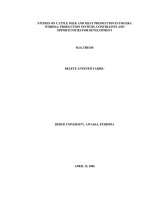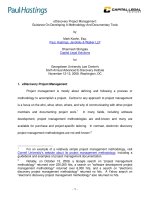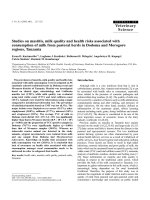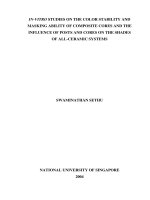Some further studies on improving QFD methodology and analysis
Bạn đang xem bản rút gọn của tài liệu. Xem và tải ngay bản đầy đủ của tài liệu tại đây (1.15 MB, 236 trang )
SOME FURTHER STUDIES ON IMPROVING QFD
METHODOLOGY AND ANALYSIS
HENDRY RAHARJO
NATIONAL UNIVERSITY OF SINGAPORE
2008
SOME FURTHER STUDIES ON IMPROVING QFD
METHODOLOGY AND ANALYSIS
HENDRY RAHARJO
(B.Eng, Petra Christian University)
A THESIS SUBMITTED
FOR THE DEGREE OF DOCTOR OF PHILOSOPHY
DEPARTMENT OF INDUSTRIAL AND SYSTEMS ENGINEERING
NATIONAL UNIVERSITY OF SINGAPORE
2008
Acknowledgements
I have been blessed with the opportunity to meet many people to whom I am truly
indebted. First and foremost, I would like to thank my coach, teacher, and also PhD
supervisor, Professor Xie Min. I learnt a lot of things from him, more than just how to
write a good research paper. I recalled that he once said “a smooth ride has nothing to
learn from”; this is particularly true for me since I have never got a smooth ride during the
course of my study. Through many ups and downs, I learnt how to like the things I do
rather than do the things I like, to do things I can rather than do the things I cannot. Those
are some lessons that I learnt from Professor Xie. Words would certainly never suffice to
express my sincere gratitude to him.
I am also honored to have Professor Aarnout C. Brombacher as my PhD supervisor.
His broad knowledge in product development process has guided me to see the big picture
in almost every research work I did. I would like to take this opportunity to sincerely
thank Professor Brombacher for his guidance, patience, support, as well as for providing
me the opportunity to do the research work at TU/e.
During my study, I have also been fortunate to meet Professor Goh Thong Ngee. I
believe that his lecture is one of the most inspiring lectures I have ever attended in my life.
I am grateful for the opportunity and would like to thank Professor Goh for his inspiring
lectures, which always spur his students’ spirit to pursue further knowledge even after the
course is over.
The latter part of this thesis work is carried out while I am working as a researcher at
Chalmers University of Technology. I have been again blessed with the opportunity to
meet my grand supervisor, Professor Bo Bergman. I have to admit that many times I am
simply astonished by his wisdom and critical thoughts. The stay here has been an eye-
opening experience for me, especially with respect to the team-work and social interaction
(Swedish ‘fika’). I am also grateful to meet Dr. Ida Gremyr and family; their kind
hospitality and support is truly appreciated. I would also like to thank my colleagues at
quality sciences division (Dr. Stefano Barone, Dr. Torben Hasenkamp, and all others) for
making my stay so enjoyable and rewarding.
i
ii
I would like to extend my gratitude to the ISE (NUS) and BPD (TU/e) faculty
members, staffs, and colleagues. Thanks to Jiang Hong, Long Quan, Wu Yanping, Zhu
Zhecheng, Aldy Gunawan, and Markus Hartono. Those people and other fellow friends
who I cannot mention their names one by one really make my stay at NUS a memorable
one. Also, thanks to Dr. Jan L. Rouvroye, Dr. Lu Yuan, Jeroen Keijzers, and other fellow
friends at TU/e, from whom I learnt quite many new things.
Before joining NUS, I was quite fortunate to meet Professor Wang Mingzhe of
Huazhong University of Science and Technology (Wuhan, China), Professor Susanti
Linuwih and Dr. Suhartono of Institut Teknologi Sepuluh Nopember (ITS, Indonesia), and
Dr. Hartono Pranjoto of Widya Mandala Catholic University (UKWM, Indonesia). It was
their support and help which encouraged me to embark on this PhD journey. I also remain
thankful to my colleagues and students at Widya Mandala Catholic University (UKWM,
Indonesia) with whom I had worked together for three years.
Finally, I would like to express my deepest appreciation to my father, my mother, and
my sister (Violin) who always support and encourage me in good or bad times. I am fully
aware of the fact that this thesis would have never been completed without the love, care,
and understanding of the flesh of my flesh, Moureen, to whom I owed many inspirations
and to whom I would like to dedicate this work.
H. Raharjo
Gothenburg, August 2009.
TABLE OF CONTENTS
ACKNOWLEDGMENTS i
TABLE OF CONTENTS iii
SUMMARY viii
LIST OF TABLES ix
LIST OF FIGURES xi
CHAPTER 1: INTRODUCTION
1.1 Problem background 1
1.2 Research questions 5
1.3 Objective and delimitation 6
1.4 Outline of thesis 8
1.5 Terminology 10
CHAPTER 2: A FURTHER STUDY ON THE USE OF ANALYTIC HIERARCHY
PROCESS IN QFD (PART 1 OF 2) – A CASE STUDY
2.1 In what ways does AHP contribute to an improved QFD analysis? 12
2.2 Using AHP in QFD: An education case study 14
2.2.1 QFD’s use in education and some problematic areas 14
2.2.2 The proposed methodology 18
2.2.3 The research design 21
2.2.4 The results 23
2.2.5 Sensitivity analysis 26
2.3 A remark on AHP’s shortcoming 27
2.4 Conclusion and implication 28
CHAPTER 3: A FURTHER STUDY ON THE USE OF ANALYTIC HIERARCHY
PROCESS IN QFD (PART 2 OF 2) – A GENERALIZED MODEL
3.1 Introduction 31
3.2 The ANP and its use in QFD 34
3.2.1 The ANP and the AHP 34
3.2.2 Existing ANP’s use in QFD and its limitations 35
3.3 Some important factors in product design using QFD 37
3.3.1 New product development (NPD) risk 37
iii
3.3.2 Benchmarking information 40
3.3.3 Feedback information 41
3.4 The proposed generalized model 41
3.4.1 The model 42
3.4.2 The model and the HoQ’s components 43
3.4.3 A suggested step-by-step procedure for using the model 45
3.4.4 Types of questions to elicit decision makers’ judgments 48
3.4.5 Group decision making using the AHP/ANP 49
3.4.6 Fuzziness in the AHP/ANP 50
3.5 An illustrative example 51
3.6 Discussion 62
CHAPTER 4: DEALING WITH THE DYNAMICS OF RELATIVE PRIORITIES:
PROPOSING A NEW MODELING TECHNIQUE
4.1 Introduction 65
4.2 Existing approaches and research motivation 67
4.2.1 Shortcoming of Saaty’s time dependent approach 67
4.2.1.1 The failure to preserve consistency over time 68
4.2.1.2 The rigidity of dynamic judgment approach 70
4.2.2 Limitation of compositional linear trend 73
4.2.3 Limitation of the DRHT approach 74
4.3 Compositional data fundamentals 75
4.3.1 Simplex sample space 75
4.3.2 Operations in the simplex 75
4.4 The proposed method: compositional exponential smoothing 76
4.4.1 General procedure 77
4.4.2 Compositional single exponential smoothing (CSES) 78
4.4.3 Compositional double exponential smoothing (CDES) 79
4.4.4 Fitting error measurement 79
4.4.5 Smoothing constant and initialization 80
4.4.6 Ternary diagram 81
4.5 An illustrative example 81
4.5.1 Model building and forecasting process using four methods 84
4.5.2 Residual analysis of the four models 87
4.5.3 Solving the case study data using Saaty’s approach 89
4.6 Discussion and limitations 92
4.6.1 Dynamic judgments and dynamic priorities 92
4.6.2 Short-term and long-term forecast 93
4.6.3 Computation efficiency 94
4.7 Conclusion 94
iv
CHAPTER 5: APPLICATION OF THE MODELING TECHNIQUE (PART 1 OF 2)
– INTEGRATING KANO’S MODEL DYNAMICS INTO QFD
5.1 Introduction 97
5.2 Kano’s model in QFD: existing approaches and research gap 99
5.2.1 Kano’s model and its dynamics 99
5.2.2 Kano’s model for multiple product design in QFD 100
5.3 Modeling Kano’s model dynamics 102
5.3.1 The input 102
5.3.2 The CDES method 103
5.3.3 Selection of model parameter 104
5.3.4 Fitting error measurement 105
5.4 Kano optimization for multiple product design 105
5.4.1 Deriving weights from the forecasted Kano percentage data 106
5.4.2 Deriving adjusted weights 107
5.4.3 Deriving DQ importance rating using Kano results 109
5.4.4 The optimization model 110
5.5 An illustrative example 112
5.5.1 Modeling Kano’s model dynamics 113
5.5.1.1 The input 113
5.5.1.2 Selection of model parameter 115
5.5.1.3 Fitting error measurement 115
5.5.1.4 Results’ interpretation 116
5.5.2 Kano optimization for multiple product design 117
5.5.2.1 Deriving weights from the forecasted Kano percentage data 119
5.5.2.2 Deriving adjusted weights 119
5.5.2.3 Deriving DQ importance rating using Kano results 120
5.5.2.4 The optimization model 121
5.6 Conclusion 122
CHAPTER 6: APPLICATION OF THE MODELING TECHNIQUE (PART 2 OF 2)
– DYNAMIC BENCHMARKING IN QFD
6.1 Introduction 124
6.2 The need of dynamic benchmarking: literature review and research gap 126
6.3 The proposed dynamic benchmarking methodology 129
6.3.1 The input 129
6.3.2 The step-by-step procedure 131
6.4 An illustrative example 132
6.4.1 The input 133
6.4.2 The process 135
6.4.3 The output and analysis 136
6.5 The competitive weighting scheme: A SWOT-based approach 139
6.6 Conclusion 143
v
CHAPTER 7: A FURTHER STUDY ON QFD’S RELATIONSHIP MATRIX:
INVESTIGATING THE NEED OF NORMALIZATION
7.1 Introduction 146
7.2 The QFD relationship matrix: some problems and research gap 148
7.2.1 Some problems in QFD relationship matrix 148
7.2.2 The research gap 149
7.3 The pros and cons of normalization in QFD 152
7.3.1 The pros 152
7.3.2 The cons 153
7.4 Some observations and a proposed rule of thumb 155
7.4.1 Some observations 155
7.4.2 A proposed rule of thumb 157
7.4.3 A validation example 159
7.5 Conclusion 163
CHAPTER 8: A FURTHER STUDY ON PRIORITIZING QUALITY
CHARACTERISTICS IN QFD
8.1 Introduction 166
8.2 The dynamic QFD (DQFD) model 168
8.2.1 Why is it important to incorporate customer needs’ dynamics? 168
8.2.2 The DQFD model 169
8.2.3 The forecasting technique 171
8.2.4 Estimation of future uncertainty 172
8.2.5 Decision making 173
8.3 The proposed methodology 174
8.3.1 A step-by-step procedure 175
8.3.2 Optimization model 1: Utilitarian approach 176
8.3.3 Optimization model 2: Non-utilitarian approach 179
8.4 An example 182
8.4.1 Using optimization model 1: Utilitarian approach 189
8.4.2 Using optimization model 2: Non-utilitarian approach 193
8.5 Discussion
8.5.1 Selection of forecasting technique 196
8.5.2 A possible implication to development of innovative products 196
8.6 Conclusion 199
CHAPTER 9: CONCLUSION AND FUTURE RESEARCH
9.1 Conclusion 201
9.2 Major contributions 202
9.3 A note on the practical implication of DQFD for innovative products 204
9.4 Future research 206
REFERENCES 207
vi
vii
Appendix A: Sample of questionnaire to elicit QFD team’s judgments 216
Appendix B: Judgments results based on arc’s category 218
Appendix C: Published commercial specification of Nokia’s 6000s series
planned to be introduced in 2007 220
Appendix D: Published commercial specification of Nokia’s 6000s series
planned to be introduced in 2008 221
Appendix E: Author’s list of publications 222
Summary
Quality Function Deployment (QFD) starts and ends with the customer. In other words,
how it ends may depend largely on how it starts. Any QFD practitioners will start with
collecting the voice of the customer that reflects customer’s needs as to make sure that the
products will eventually sell or the service may satisfy the customer. On the basis of those
needs, a product or service creation process is initiated. It always takes a certain period of
time for the product or service to be ready for the customer. The question here is whether
those customer-needs may remain exactly the same during the product or service creation
process. The answer would be very likely to be a ‘no’, especially in today’s rapidly
changing environment due to increased competition and globalization.
The focus of this thesis is placed on dealing with the change of relative importance of
the customer’s needs during product or service creation process. In other words, the
assumption is that there is no new need discovered along the time or an old one becomes
outdated; only the relative importance change of the existing needs is dealt with.
Considering the latest development of QFD research, especially the increasingly extensive
use of Analytic Hierarchy Process (AHP) in QFD, this thesis aims to enhance the current
QFD methodology and analysis, with respect to the change during product or service
creation process, as to continually meet or exceed the needs of the customer.
The entire research works are divided into three main parts, namely, the further use of
AHP in QFD, the incorporation of AHP-based priorities’ dynamics in QFD, and decision
making analysis with respect to the dynamics. In brief, the main contribution of this thesis
is in providing some novel methods and/or approaches to enhance the QFD’s use with
respect to the change during product or service creation process. It is hoped that the
research work may provide a first step into a better customer-driven product or service
design process, and eventually increase the possibility to create more innovative and
competitive products or services over time.
viii
LIST OF TABLES
Table 2.1: DQs’ priorities change for employers’ group sensitivity analysis 26
Table 2.2: QCs’ ranks change for employer’s group 27
Table 3.1: Difference between AHP and ANP 35
Table 3.2: Questions for eliciting QFD team’s judgments 48
Table 3.3: Cluster matrix 59
Table 3.4: Unweighted supermatrix without arc 16 59
Table 3.5: Weighted supermatrix without arc 16 60
Table 3.6: Limit supermatrix without arc 16 60
Table 3.7: Limit supermatrix after QC’s target setting (with arc 16) 61
Table 3.8: QC priorities before and after target setting phase 61
Table 4.1: The priorities change over time using Saaty’s method 69
Table 4.2: The actual, fitted, and forecast data of the example 82
Table 4.3: Residual of the four methods using Euclidean and Aitchison distance 88
Table 4.4: Residual statistic and normality test based on Aitchison distance 89
Table 4.5: Judgment data and fitting results using the dynamic judgment approach 90
Table 5.1: Actual, fitted, forecasted, and fitting error values for DQ
11
and DQ
12
114
Table 5.2: Actual, fitted, forecasted, and fitting error values for DQ
21
and DQ
22
114
Table 5.3: Actual, fitted, forecasted, and fitting error values for DQ
31
and DQ
32
114
Table 5.4: Input data for optimization model 119
Table 5.5: Multiple product design optimization results 122
Table 6.1: DQs’ priorities (IR values) over time 133
ix
x
Table 6.2: Customer competitive assessment over time for DQ
1
134
Table 6.3: Customer competitive assessment over time for DQ
2
134
Table 6.4: Customer competitive assessment over time for DQ
3
135
Table 6.5: The proposed competitive weighting scheme 141
Table 6.6: The determination of final DQs’ priority 142
Table 7.1: HoQ example when normalization is desirable: before normalization 152
Table 7.2: HoQ example when normalization is desirable: after normalization 153
Table 7.3: HoQ example when normalization is undesirable:
before normalization 154
Table 7.4: HoQ example when normalization is undesirable: after normalization 155
Table 7.5: HoQ of combined model for the basic product before normalization 160
Table 7.6: HoQ of combined model for the basic product after normalization 160
Table 7.7: HoQ of combined model for the high-end product
before normalization 162
Table 7.8: HoQ of combined model for the high-end product after normalization 162
Table 8.1: Actual, fitted, forecasted, and fitting error values of all IR 184
Table 8.2: Descriptive statistics and normality test of forecasting residual 185
Table 8.3: Mean value test of forecasting residual 185
Table 8.4: Independence test of forecasting residual 186
Table 8.5: Optimization results with SD constraint 192
Table 8.6: Optimization results without SD constraint 193
Table 8.7: Example of customer preference dynamics from commercial
specification 198
LIST OF FIGURES
Figure 1.1: Time-lag problem when using QFD 2
Figure 1.2: Dynamics in the House of Quality 4
Figure 1.3: Illustration for customer’s needs’ relative priorities dynamics 5
Figure 1.4: Organization of the thesis 8
Figure 2.1: The proposed methodology of using AHP in QFD 21
Figure 2.2: An example of students’ group hierarchy 23
Figure 2.3: Trimmed part of HoQ for students’ group 24
Figure 2.4: Trimmed part of HoQ for lecturers’ group 24
Figure 2.5: Complete HoQ for employers’ group 25
Figure 3.1: The proposed ANP framework for QFD 43
Figure 3.2: Network model for the example 53
Figure 4.1: Consistency Ratio (CR) values over time using Saaty’s method 70
Figure 4.2: Ternary diagram of Saaty’s method (Saaty, 2007) 71
Figure 4.3: Ternary diagrams of a random AHP matrix with 1000 replications
using pre-specified CR range 72
Figure 4.4: Ternary diagram of the relative priorities change over 12 periods 82
Figure 4.5: Ternary diagram of fitting historical data using four methods (a-d) 85
Figure 4.6: Plot of actual, fitted and forecasted priorities using
the DRHT and the CDES method 87
Figure 4.7: (a) Plot of actual, fitted and forecasted judgments values using
Saaty's approach, (b) Ternary diagram of actual, fitted, and
forecasted priorities using Saaty’s approach 91
Figure 5.1: Graph of actual, fitted, and forecasted values for DQ
11
and DQ
12
116
xi
xii
Figure 5.2: Graph of actual, fitted, and forecasted values for DQ
21
and DQ
22
116
Figure 5.3: Graph of actual, fitted, and forecasted values for DQ
31
and DQ
32
117
Figure 6.1: Graphical plot of the actual, fitted, and forecasted values of
the DQs’ priorities 136
Figure 6.2: Graphical plot of the actual, fitted, and forecasted values of
the customer competitive assessment priorities for DQ
1
137
Figure 6.3: Graphical plot of the actual, fitted, and forecasted values of
the customer competitive assessment priorities for DQ
2
137
Figure 6.4: Graphical plot of the actual, fitted, and forecasted values of
the customer competitive assessment priorities for DQ
3
137
Figure 6.5: The radar diagram portraying the future competitive assessment 138
Figure 6.6: The proposed weighting scheme 141
Figure 7.1: Pareto chart of combined model for the basic product 161
Figure 7.2: Pareto chart of combined model for the high-end product 163
Figure 8.1: The DQFD model 170
Figure 8.2: Simplified HoQ for employers of graduates 183
Figure 8.3: Graphical plot of the actual, fitted, and forecasted
importance rating values 187
Figure 8.4: The DQFD for the employers of graduates 188
Figure 8.5: Plot of CDF of all QCs 189
Chapter 1: Introduction
CHAPTER 1
INTRODUCTION
“The customers of tomorrow will have needs and expectations different from those of our present customers.
For this reason, it is important to keep up with changing needs and expectations, and to learn how to meet
these…” (Bergman and Klefsjö, 2003: quality from customer needs to customer satisfaction)
“Indeed a Critical-to-Quality (CTQ) valid today is not necessarily a meaningful one tomorrow; shifting
social, economic and political scenes would make it imperative that except for immediate, localized projects,
all CTQs should be critically examined at all times and refined as necessary” (Goh, 2002: a strategic
assessment of six sigma)
1.1 Problem Background
Quality Function Deployment (QFD) was first developed in the late 1960s by
Professor Yoji Akao and Shigeru Mizuno. It was motivated by two issues (Akao and
Mazur, 2003). First, it is the importance of design quality. Second, the need to deploy,
prior to production startup, the important quality assurance points needed to ensure the
design quality throughout the production process. According to Akao (1990), as one of the
main founders, QFD can be defined as “a method for developing a design quality aimed at
satisfying the customer and then translating the customer’s demand into design targets and
major quality assurance points to be used throughout the production phases”.
QFD has become a quite popular tool in customer-focused product creation or
development process. Some main benefits of using QFD may include better
communication of cross-functional teamwork, lower project and product cost, better
product design, and increased customer satisfaction (Hauser and Clausing, 1988; Griffin
and Hauser, 1992; Hauser, 1993; Presley et al., 2000; Chan and Wu, 2002a; Xie et al.,
2003). As with any other tools, QFD also has some limitations apart from its benefits. It is
1
Chapter 1: Introduction
limited in the sense that it is more effective for developing incremental products as
opposed to really new products (Griffin, 1992). It is also found that the QFD’s use might
be a bit burdensome due to the incredibly big matrices (Den Ouden, 2006). Furthermore, a
quite recent empirical study also found that QFD does not shorten time-to-market (Lager,
2005).
Nevertheless, taking into account its limitations, QFD does still provide a more
systematic and effective approach to create higher customer satisfaction by bringing a
product or service that the customer wants. In essence, QFD starts and ends with the
customer. By employing QFD, everyone involved in every stage of product or service
creation process may be able to see how the job one is doing can contribute to the chief
end goal, namely, to meet or exceed the end customer’s needs. Such mechanism is a good
way to make sure that the products will eventually sell.
One important key factor for successful application of QFD is the accuracy of the
main input information, namely, the Voice of Customer (VOC) (Cristiano et al., 2001). It
is known that it always takes some time from the time when the customer’s voice is
collected until the time when the product is ready to be launched, as shown in Figure 1.1.
Start
CUSTOMER
Collect VOC Design Process Production
Other phases
Product Purchase
End
CUSTOMER
QFD
Time Lag
Figure 1.1 Time-lag problem when using QFD
The time-lag duration may certainly vary from one product to another. For example, if it
takes one year time, then the question is whether the product which is about to be
launched may still meet the customer’s needs since it is created based on the customer
2
Chapter 1: Introduction
voice which was collected one year ago. The answer to this question is very likely to be a
‘no’ in the context of today’s rapidly changing market. This, at the same time, assumes
that the rate of change is shorter than or the same as the length of product or service
creation time, for example, the rate of change is yearly and the product or service creation
time is one year or longer.
In the existing QFD literature, there has been too little research devoted into dealing
with the change of customer’s needs during product or service creation process. What
have been done in the literature to tackle such change is to use two types of approaches,
namely, sensitivity analysis (Xie et al., 1998) and forecasting techniques (Shen et al., 2001;
Xie et al., 2003; Wu et al., 2005; Wu and Shieh, 2006). Considering the development of
QFD research in recent years, particularly the increasingly extensive research on the use
of the Analytic Hierarchy Process (AHP)
1
in the QFD (Carnevalli and Miguel, 2008; Ho,
2008), those approaches might no longer be effective. Furthermore, almost all of the
previous approaches, which employ forecasting techniques, only rely on a single point
estimate of forecast.
This thesis is written based on a collection of the author’s scientific journal
publications (see Appendix E) which attempts to provide further studies on the methods or
approaches in QFD with respect to the dynamics of QFD’s input information during
product or service creation process. Specifically, the focus is placed on the two elements
in the house of quality (Figure 1.2), namely, the customer’s voice (left wing) and the
competitive benchmarking information (right wing). Those two parts are most likely
1
In 2007, the inventor of AHP (Thomas L. Saaty) was awarded the Akao Prize for the remarkable
contribution of AHP in QFD ( />)
3
Chapter 1: Introduction
subject to change over time since they are obtained externally from the customer’s
judgment or assessment.
Whats/
Demanded
Quality
Correlation Matrix
Hows/ Qualit
y
Characteristic
Relationship Matrix
Planning
Matrix/
Customer
Competitive
Assessment
Technical Matrix
Figure 1.2 Dynamics in the House of Quality
The entire research works are divided into three focal parts, namely, the further use of
AHP in QFD, the incorporation of AHP-based priorities’ dynamics in QFD, and decision
making analysis with respect to the dynamics. Note that the term ‘dynamic’ is interpreted
as the change over time throughout the thesis (see Section 1.5). It is worth highlighting
that the dynamics that this thesis discusses is the change of relative priorities, which are
obtained using the AHP, over time. The word ‘relative’ here implies that the priorities are
dependent on a certain condition set by the people at a certain place and time. In other
words, those priorities will definitely not remain exactly the same at all time.
An illustrative example of how the relative priorities of three different customer-
needs or demanded qualities (DQs) change during eight periods is shown in Figure 1.3.
The w
1
, w
2
, w
3
, respectively denote the relative weights (priorities) of DQ
1
, DQ
2
, and DQ
3
.
The priorities of the needs may reflect the relative importance or customer’s preference of
the needs. Note that the three DQs themselves have already existed from the beginning of
the analysis. The only change is their relative priorities or importance over time. In
addition, the sum of the priorities of the three DQs for every period is always one (100%).
4
Chapter 1: Introduction
Figure 1.3 Illustration for customer’s needs’ relative priorities dynamics
1.2 Research Question
Reflecting upon the existing QFD literature and the problem described in Section 1.1,
the following main research question is formulated:
Main research question: How to enhance the current QFD methodology and analysis,
especially when the AHP is used in QFD, with respect to the dynamics during product
or service creation process as to continually meet or exceed the needs of the customer?
To answer the above question, three more specific sub-questions are formulated with
respect to the current use of AHP in QFD, the incorporation of AHP-based dynamics into
the house of quality (HoQ), and how to make decision with respect to such dynamics.
Sub-question 1: In what ways does AHP, considering its strength and weakness,
contribute to an improved QFD analysis? The AHP has been widely accepted as a
realistic, flexible, simple, and yet mathematically rigorous modeling technique in multiple
criteria decision making (MCDM) field. A recent survey found that the growth of AHP-
related publications has been enormous during the last three decades (Wallenius et al.,
2008). However, as with any other tool, the AHP is also plagued with shortcomings, such
as, the rank reversal phenomenon and the exponentially growing number of pairwise
comparisons as the number of alternatives being compared gets larger (Raharjo and Endah,
5
Chapter 1: Introduction
2006; Wang et al.,1998). Considering its strength and weakness, this thesis will attempt to
answer the above question by not only explaining the ways AHP may contribute to an
improved QFD analysis, but also providing a better or generalized use of AHP in QFD.
Sub-question 2: How to use the AHP in QFD in dealing with the dynamics of
priorities? The QFD-AHP combination is found to be one of the most popular tools in the
QFD and/or integrated AHP literature in recent years (Ho, 2008; Carnevalli and Miguel,
2008). The term ‘integrated AHP’ is used to refer to other techniques used in combination
with the AHP (Ho, 2008). Most researchers use the AHP to derive the relative importance
of customer’s needs (Armacost et al., 1994; Lu et al., 1994; Park and Kim, 1998; Köksal
and E÷itman, 1998; Zakarian and Kusiak, 1999; Kwong and Bai, 2003; Raharjo et al.,
2007, 2008; Li et al., 2009). Unfortunately, there is almost no study that deals with the
dynamics of AHP-based priorities.
Sub-question 3: How to make decision in a QFD analysis with respect to the
dynamics in the house of quality? This question is a continuation of sub-question 2. The
focus is on how to make decision, with respect to the change of AHP-based priorities in
the HoQ during products or service creation process, as to continually meet or exceed the
needs of the customer. This question may be divided into two smaller questions. One is
how to use the priorities’ dynamics modeling results as the input of the decision model,
and the other is what kind of decision making models that can be used.
1.3 Objective and Delimitation
In general, the main objective of this thesis is to develop novel methods and/or
approaches for enhancing the use of QFD, especially in combination with the AHP, in
6
Chapter 1: Introduction
dealing with the dynamics during product creation process. It is expected that those
methods or approaches, in the long run, may increase the possibility to create innovative
and competitive products or services. In particular, this thesis aims to achieve the
following three specific objectives based on the three research sub-questions:
1. To demonstrate the usefulness as well as to provide a better use of the AHP in QFD.
2. To develop a novel method to model the dynamics of AHP-based priorities in the
house of quality.
3. To develop methods and/or approaches for decision making with respect to the
modeling results as to continually meet or exceed the needs of the customer.
Delimitation of the first objective: The usefulness and better use of the AHP in QFD is
delimited to only the first matrix, namely, the house of quality. A real-world case study in
education will be used to demonstrate the usefulness, and one empirical example based on
interview and questionnaire will be used to show how to use AHP better in QFD.
Delimitation of the second objective: The novel method to model the dynamics of AHP-
based priorities in the house of quality is only applied to two parts of the HoQ. One is in
the customer-needs’ priorities (importance rating part), and the other is in the priorities of
competitive assessment of customer’s needs (competitive benchmarking part). It is also
delimited to the fact that it does not include the case of when a new customer need should
be added or an old one should be removed along the time, although it may be common in
practice. In other words, it only deals with the change of the relative priorities over time.
7
Chapter 1: Introduction
Delimitation of the third objective: The focus is delimited to the translation process and
the decision making analysis using the modeling results. With respect to the translation
process, it is not the objective of this thesis to elaborate how a customer need gets
translated into a specific design or technical attribute, but rather how to use the
relationship matrix in the HoQ to obtain the priorities of the technical attributes properly.
The decision making analysis is delimited to two kinds of optimization model; one
employs a utilitarian approach and the other employs a non-utilitarian approach.
1.4 Outline of the thesis
This thesis is comprised of nine chapters. Chapter 1 provides the problem background,
research questions, objectives, delimitations, outline, and terminologies used in the thesis.
Chapter 2 to Chapter 8 contains the main contributions of the thesis which is derived from
the author’s scientific publications (Appendix E). Chapter 9 concludes the thesis with the
summary of main contributions and possible future research. With respect to the three sub-
questions, the chapters are organized as depicted in Figure 1.4.
SubͲquestion 1 SubͲquestion 2 SubͲquestion 3
ResearchQuestion
Chapter2 Chapter3 Chapter4
Chapter5 Chapter6
Chapter7
Chapter8
Figure 1.4 Organization of the thesis
8
Chapter 1: Introduction
Chapter 2 and Chapter 3 will address the first research sub-question that corresponds
to the first specific objective. Chapter 2 will discuss the ways AHP may contribute to an
improved QFD analysis based on the literature. Then, a real-world case study of QFD
application in improving education quality is described. This is to substantiate the
usefulness of AHP in QFD. The need to incorporate the dynamics of customer’s needs in
QFD is also indicated in Chapter 2. Chapter 3 provides a better use of the AHP in QFD
via the generalized form of the AHP, namely, the Analytic Network Process (ANP).
Finally, a remark on the AHP’s shortcoming when the number of alternatives being
compared gets larger is provided.
Chapter 4 will address the second research sub-question which corresponds to the
second specific objective. A novel technique to model the dynamics of AHP-based
priorities is proposed. The proposed modeling technique is applied to two areas as to
advance the QFD literature. The first area (Chapter 5) is in enhancing the use of Kano’s
model in QFD. Based on the recent advancement, a systematic methodology to
incorporate Kano’s model dynamics in QFD is suggested. The second area (Chapter 6) is
in enhancing the benchmarking part of QFD, that is, by including the dynamics of
competitors’ performance in addition to the dynamics of customer’s needs.
Chapter 8 will address the third research sub-question which corresponds to the third
specific objective. Before proceeding to the decision making analysis (Chapter 8), Chapter
7 will first discuss an important issue in the relationship matrix. This is owing to the fact
that the relationship matrix is almost always used in deriving the technical attributes’
priorities, which are the main output of the HoQ. Chapter 8 will propose a systematic
methodology, using the case study in Chapter 2, to incorporate the dynamics of DQs’
priorities into the decision making analysis in the QFD. Two kinds of approaches are
9
Chapter 1: Introduction
proposed to prioritize and/or optimize the technical attributes with respect to the future
needs of the customer. The results from Chapter 5 and Chapter 6 may also be used in
combination with the proposed methodology. A practical implication of the research work
towards the possible use of QFD in helping a company develop more innovative products
will also be discussed.
Chapter 9 concludes the thesis and provides a summary of the major contributions.
Some directions for the extension of the current research are described. It is expected that
the entire study in this thesis may provide a first step to better use QFD with respect to the
change of customer needs’ importance and their competitive assessment during product or
service creation process.
1.5 Terminology
This section provides the important terminologies used in this thesis. The purpose here
is to provide clearly defined terms and to avoid misinterpretation of the meaning. There
are seven important terminologies used throughout this thesis.
x demanded quality (DQ) – this term is used to refer to customer’s needs, attributes, or
requirements. It is also known as the ‘Whats’ in the HoQ. In this thesis, this DQ is
used interchangeably with the voice of the customer (VOC). Note that the essential
different between these two is in the formulation of the language, the VOC is derived
from the customer’s daily language, while the DQ is more formal or specific.
x quality characteristic (QC) – this term is used to refer to the design attributes or
parameters, or the technical/engineering attributes. It is also known as the ‘Hows’ in
the HoQ.
10
Chapter 1: Introduction
11
x priority – this term is used to represent the weight assigned to a specific attribute, for
example, the weight of a DQ or a QC. This weight or priority refers to relative priority
that is obtained from the AHP. It is also used to represent the relative competitive
assessment of a DQ.
x DQ’s priority – In this thesis, this refers to the relative weight assigned to a DQ. It
also refers to the importance rating value (IR value) of the DQ.
x QC’s priority – This refers to the final relative weight of a QC which will usually be
used in an optimization framework.
x dynamics – this word is used to refer to the change over time. In this thesis there are
two types of dynamics. One is the dynamics in the DQs’ priorities and the other is the
dynamics in the DQs’ competitive assessment.
x QFD team – This term is used to refer to a number of people from various functional
groups who together use QFD. It is also used to refer to QFD users or QFD
practitioners.









